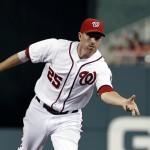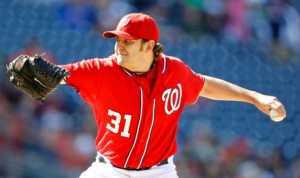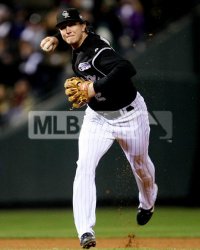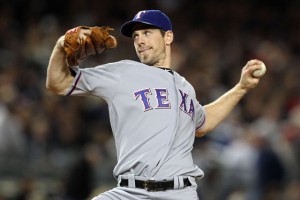
The Nats entire off-season plan revolves around what Adam LaRoche does. Photo Alex Brandon/AP via wp.com
I havn’t done a “how would I answer this chat question” from The Washington Post’s Tom Boswell in a while, but on the back of his 11/26/12 “Stay the Course” opinion piece in the Washington Post (where he basically advises that the team should stay out of the major FA market this off-season), I thought I’d chime in and read/respond to his 11/26/12 chat.
My opinion on Boswell’s piece; I don’t think you can stand pat in today’s baseball world. Yes this team won 98 games last year. But does anyone think we’ll win 98 games again by doing little to nothing to address the team’s needs? Trying to replace Adam LaRoche and Edwin Jackson‘s departures internally has a large chance of weakening the team, and I believe we need to explore a significant FA purchase (or a trade) this off-season. Now, inarguably TV deals and the rising revenue streams are fueling the FA market, and we’re already seeing contracts that heretofore would have been immediately labeled as “over pays.” Therefore, even if the Nats go after a 2nd or 3rd tier player in free agency, they’re going to be compensated far more than we ever thought their value represented. But this is just the way the baseball world is going; we can no longer say that someone is “overpriced” … we need to remember that everyone is going to be “overpriced.” Perhaps Jayson Werth‘s $126M/7yr deal will look like a bargain in a few years.
And this is before even addressing the impact that the amazing new Los Angeles Dodger’s TV deal, reportedly worth between $6 and $7 billion dollars over 25 years, will have on the baseball world. Even at the low-end estimate, that’s $240M a year in RSN revenue. $240M a year! They could field a $200M team, pay luxury taxes and still have money to spare under this deal, and that’s before a single dollar in gate, game-day revenues, suites, parking or merchandising comes in. To call this a “game-changer” is an understatement; I think this could be a serious issue facing Baseball in the coming years. We’re already seeing what the new ownership group is capable of doing in terms of acquiring talent without much regard to payroll. What happens if they also acquire the likes of Josh Hamilton and Zack Greinke this coming winter? A quick check of Cot’s page shows that Los Angeles has $169.5M committed to its top 14 players right now, with three guys making > 20M and nine total with pay > $11M/year. And they’re reportedly in the mix for the top FAs this off-season, potentially adding 20-30M more to that base number. That’s amazing. Just more revenue sharing for Jeffrey Loria to pocket I guess (Thanks Bud!).
Anyway, back to the chat responses. As always, I write my response before reading his, and sometimes edit questions here for clarity/conciseness. I’m only answering baseball-related questions, ignoring the slew of Redskins issues.
Q: Are the Nats positioning themselves to make a strong push in the next two drafts?
A: This is what I whittled down a long-winded, rambling “question” to. The gist is that a comp pick from Adam LaRoche leaving, plus another potential comp pick if Michael Morse leaves next year could help re-stock the farm system. I’d tend to say, “maybe.” The Nats are no longer where they were in 2009 and 2010, getting franchise players by virtue of back to back awful seasons. So the likelihood of finding an impact player is far less. That being said, having multiple first and supplemental first round picks is a great way to find players and to get guys who “slipped” due to signability/injury issues (as Lucas Giolito did this year).
The Nats farm system has taken some hits in the last two seasons; one from trade (losing 4 top-10 players in the Gio Gonzalez trade) and then another from injury concerns for its top guys (Sammy Solis, Matthew Purke, Lucas Giolito, and Anthony Rendon all representing 1st and 2nd round talents who suffered either season-ending injuries or significant injuries curtailing their progression in the last calendar year, to say nothing of injuries to lower-level guys like Taylor Jordan who will provide depth rising up). This thinned farm system may prevent Rizzo from making the kind of deal he made last summer, and he may want to focus on getting some more depth in the 2013 draft, as much as is possible from drafting so low.
Here’s the issue writing my own response before reading Boswell’s: he didn’t even talk about the draft portion of the “question,” instead talking about the FA pitcher angle.
Q: What do you think the team is planning on doing to replace Edwin Jackson?
A: I’d guess the team is working on two fronts: one looking at possible trade angles with teams that have surplus starting pitching (Arizona, Tampa Bay, Oakland, Los Angeles Dodgers and perhaps even Atlanta) and seeing if he can swing a deal. Then I’d guess he’s looking at a 2nd tier of starters, looking to avoid the Greinke sweepstakes (despite his affinity for the hurler). I do NOT think the team is going to tender John Lannan, instead looking to get a better pitcher for slightly more money than the $5M he’d likely earn at a minimum in 2013. Of course, with the prices we’ve seen for lefties already perhaps we will tender Lannan and consider another $5M insurance policy a bargain. Boswell scrolls through the same 2nd tier of starters, noting that there’s definitely someone out there who could work. He also mentioned the team may look at re-signing Zach Duke, though I’d be surprised by that. Why would we re-sign Duke but non-tender Lannan, if Lannan clearly is a better pitcher?
Q: Is the lack of a MASN deal hindering the Nats FA plans?
A: You have to think it is. If the Nats knew what they were getting next year, they’d certainly have a better idea of how much they could spend. The fact that Bud Selig has allowed Peter Angelos to hijack this MASN revenue negotiation for this long is deplorable. Of course, by waiting this long with the negotiations Angelos has only cost himself money, as the price we can command as a franchise certainly skyrocketed between the end of 2011 and now. So there’s that. But its clear the team is getting a pittance as compared to other comparably sized markets (Houston, Philadelphia) and needs a larger share. Boswell doesn’t think the lack of a deal is affecting the team’s plans, mostly because there’s not a $250M player on the market this year as there was last year.
Q: Were you invited to any of the seven off-season Nationals player weddings?
A: I wasn’t. Boswell wasn’t either. 🙂
Q: Why did the MLB allow the Marlins trade to go through? It poisons Miami against baseball probably for a decade and will surely be seen as a cautionary tale for city governments for at least as long.
A: Simple reason: Selig is buddies with Jeffrey Loria and has enabled his crummy behaviors for nearly 2 decades. More complex reason: on the face of it, from a purely baseball sense this trade was little different than the Boston-Los Angeles trade, and I’d guess you would have a hard time accepting one and denying the other. Loria’s position with Miami is not Selig’s concern; he got the new stadium that Selig claims is necessary in every market and Loria clearly will continue to profit from the team. To an owner, that’s the primary concern. And Selig works for the owners. All of us bloggers and columnists to deplored the trade and Loria in general (including me, in this space in September and again in November) and talk about the sanctity of the game are just blowing hot-air. Selig doesn’t care. Boswell didn’t really answer the question, just saying that baseball is dead in Miami for a long, long time. Hey, it only helps the Nats to have a 110 loss team in the division, right?
Q: Is Adam LaRoche destined for the AL as an aging 1st baseman?
A: I don’t think so; the questioner compared LaRoche to Adam Dunn, who can DH and is more valuable in the AL. Inarguably aging sluggers fare better in the AL … but LaRoche just won a gold glove for his defense at first base. He isn’t exactly a plodding first baseman slowed by age. He should be able to capably play the position for several more years, through whatever contract he’s about to sign. Boswell agrees that this is the trend, and says that Baltimore is a possible destination … but mentions nothing about LaRoche’s plus defense.
Q: Why aren’t the Nats making a bigger play for Edwin Jackson?
A: A good question. I questioned the Nats lack of a Qualifying Offer being extended to Jackson and surmised it was because the team was afraid he’d take it (having a history of working on one-year deals). So clearly the lack of the Q.O. indicates a new direction for the team. I don’t think its related to his meltdown in the post-season; that can happen to anyone (see most of our pitching staff not named Ross Detwiler). I’d guess that it relates somehow to Jackson’s maddening capabilities; shutdown power pitcher one night, gopher-ball machine the next. I think they’re just going in a different direction. Boswell says Jackson wants a 5-year deal … which if true even more reinforces my questioning of the lack of the Q.O. I disagree with his sentiment that the team is “saving room” for the rising farm system arms; to me a prospect starter is not a solution until the day he arrives in the majors and gives you 30 starts.
Q: Why did Tampa extend Evan Longoria?
A: The team had him under baseball’s most team-friendly contract (6yrs, $17.5M with three team options, locking him to Tampa from 2008 til 2016). One of baseball’s best players, he made just $2M and $4.5M in the last two seasons. Which is just ridiculous. I feel Tampa did the extension to show good faith to the player who was just so woefully underpaid. Boswell didn’t really answer the question, just saying its a good move because hitters come back from injury better than pitchers.
Q: Should the team be worried about losing LaRoche and his lefty power?
A: Yes absolutely. Which is why the team should either try to get him to sign a reasonable deal (3 years max) OR the team should let him walk and try to replace the lefty power on the FA market (perhaps in the form of someone like Nick Swisher, who won’t be cheap but also can stick in LF for a while and should fit in nicely to the clubhouse). Or maybe the team swings a deal for a lefty outfielder in trade and sticks Morse at first. Boswell agrees, thinking that LaRoche’s hot FA market will get him a 4 year deal for more money than the Nats are willing to pay.
Q: Is there any chance that MASN just cuts ties with the Nats and frees us from the awful deal?
A: No. Chance. In. Hell. Angelos stands to get such massive, major profit from this deal that he’ll die before giving in. There is just no way. And more and more its looking like this pact with the devil, which enabled the team to move here, will be a limiting factor in the years to come. People talk about how Atlanta has the worst TV deal in the MLB? Well what about the Nats? Boswell asked Selig about this and was told that “everything is on the table.” I highly doubt that, but I’m not going to call Boswell a liar. I’ll just say, “Don’t hold your breath” that the Nats will be allowed to extract themselves from MASN and create their own RSN. This would be the absolute dream scenario, but I just cannot see Selig backpeddaling on this deal less than a decade after it was signed.
Q: Will the Nats learn the lessons heeded by other big-money teams who got saddled with old, expensive players?
A: Hopefully so. Not giving LaRoche 4 years would be a signal to that end. But it can be difficult; what happens when the whole core of our young team hits free agency? That’s a lot of big checks to write, and the fan base will bemoan every star that is allowed to walk. Boswell thinks LaRoche is consistent enough to warrant the contract, but also notes that he’s several years past the typical hitter prime.
Q: Is Morse really the better choice at 1B if it’s between him and Moore? Is he really just that bad in the OF?
A: I’m convinced this narrative is overplayed. Morse was a shortstop coming up through the minors, so he’s not exactly immobile, and suddenly nobody remembers that Tyler Moore was a plodding minor league first-baseman who only tried LF for the first time in spring training of last year. Now suddenly Morse isn’t the better LF option? I don’t buy it. Neither are great LF choices; Morse had a -23.3 UZR/150 in 493 innings while Moore had a -22.7 in 229 innings this past season (small sample sizes both). So it seems they’re both awful out there. But then again (as I’ve said many times) you can “hide” guys in LF if they’re big bats. You take the lesser defense in order to get a middle-of-the-order hitter. The last thing you want is a #8 hitter (think Xavier Nady) bumbling around in LF and hitting .190. If we lose LaRoche, I think the team should put Moore back in his natural position at 1B and let Morse get one more season out there. Boswell didn’t answer the question, instead rambling about something else.




